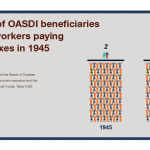Winter 2020 newsletter: Director’s corner
March 9, 2020
John Laitner The Social Security Bulletin, Vol. 80, No. 1 (February 2020), was devoted to review articles on activities over the fiscal years 2008 to 2017 of the three retirement and two disability research centers sponsored by the Social Security…
Read moreMoney isn’t everything—at least for older workers
October 15, 2019
In 2015, Nicole Maestas, Kathleen J. Mullen, David Powell, Jeffrey Wenger, and Till von Wachtner fielded two surveys. One asked respondents about their working conditions; the second asked about their preferences for certain job characteristics. The nine working conditions were…
Read moreWealthy, educated retirees benefit from tax-advantaged retirement savings
September 18, 2019
Tax-advantaged savings plans—such as IRAs, Keogh, 401ks—have a significant tax cost. Understanding their roles and effectiveness in retirement funding is crucial to assessing whether their benefits outweigh their price. Until fairly recently, measuring these accounts’ economic impact was difficult because…
Read moreTracking the elusive irregular IRA withdrawal
August 14, 2019
If Michael Hurd, Erik Meijer, Philip Pantoja, and Susann Rohwedder’s “Addition to the RAND HRS Longitudinal Files: IRA Withdrawals in the HRS, 2000-2014” were a home improvement project, the researchers would have put up spacious bookshelves in the Health and…
Read moreHow are older workers’ employment prospects affected when there are fewer younger workers?
July 17, 2019
“This [project] is prompted by a question I’ve been asked by many reporters, which is ‘With larger, older cohorts and relatively scarce younger workers, will employers shift to employing more older workers for one reason or another?’” investigator David Neumark…
Read moreSolvency: potential solutions meet a complex world
June 18, 2019
Many proposed reforms might have varying affects on retirees. In the 1940s, if a man lived to age 65, the full retirement age (FRA), he would, on average, live another 12.7 years in retirement, while a woman would live another…
Read more
Potential trust fund fix: Encouraging longer work
May 21, 2019
Sometimes researchers create structural economic models to help understand the Old Age and Survivors Insurance (OASI) and Disability Insurance (DI) trust funds’ solvency issues and to test possible solutions. Taking information (data) from real life, they build a picture of…
Read moreA beginner’s guide to the Social Security trust funds’ solvency
April 9, 2019
How to fix the solvency issues of the Old Age and Survivors Insurance (OASI) and Disability Insurance (DI) trust funds, often referred to as the Social Security trust funds (OASDI), continues to concern policymakers and voters alike. As a pay-as-you-go…
Read moreRetirement: It’s a Family Affair
March 14, 2019
While research often focuses on the retirement bound individual or couple, few people live their lives with no outside influences. A parent’s desire to lighten a child’s burden could have a negative impact on the parent’s retirement security, and such…
Read moreMRRC to become MRDRC (Michigan Retirement and Disability Research Center)
October 22, 2018
In September, Michigan Retirement Research Center (MRRC) was awarded its fifth five-year cooperative agreement renewal from the Social Security Administration. MRRC Director and Principle Investigator John Laitner explained that as part of the grant proposal, MRRC agreed to include disability…
Read more